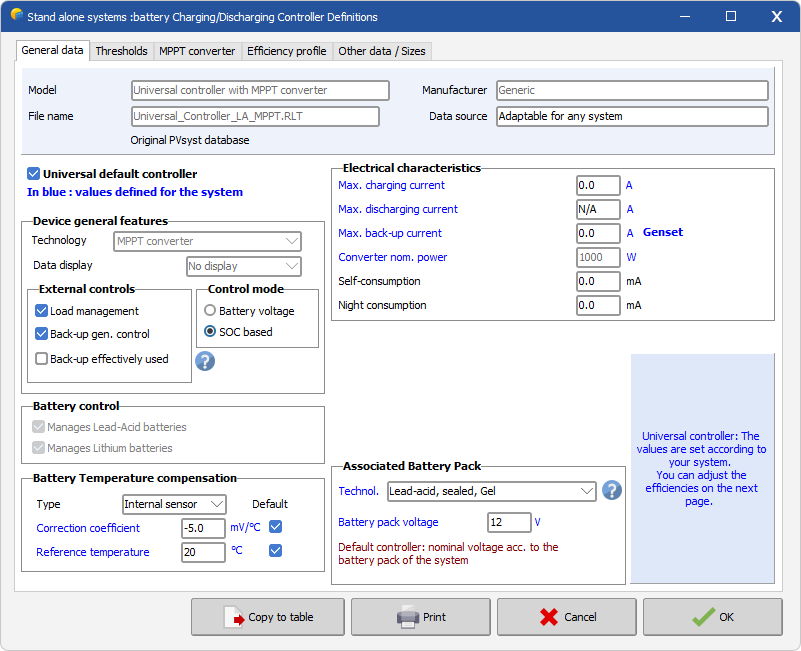|
<< Click to Display Table of Contents >> Controllers - Main interface |
  
|
|
<< Click to Display Table of Contents >> Controllers - Main interface |
  
|
Even though sophisticated regulation modes can be used in some photovoltaic systems (proportional regulators, partial cuts in fields, for example), the type of regulator currently available in PVsyst will only act on an "On/Off" basis.
Its decisions are based on the modelled battery voltage. Each action is characterised by two thresholds - starting and stopping - which can be given either in specific values by element, or for the whole battery.

Controller parameters
Besides identification as in other components (model, manufacturer, etc), the controller parameters include:
| - | Technology and Data display specification. These are only indicative parameters, except that MPPT or DC-DC converters are specified by the "Technology" choice. |
| - | Charging thresholds, for which default values proposed by the program are slightly dependent on the battery technology. |
| - | Discharging thresholds are the regulator settings controlling the load disconnecting, ensuring the battery deep discharge safety. |
| - | Temperature compensation (linear) is available with some regulators, especially recommended for use in warm countries. Some controllers have an internal sensor (they measure their own temperature), other have external sensor to measure the battery temperature. |
| - | Maximum Input and Output currents are one of the most important real device characteristics. Before simulation the program will check the consistency of the controller choice with the system characteristics. |
| - | Associated battery pack: most controllers are suited for one - or sometimes two switchable - battery voltage. The simulation process needs knowing this switch position, and updates it at simulation time. As thresholds are slightly dependent on the battery technology, we also have to define them here. |
| - | Back-up generator management is rarely available with little PV systems. When controlling the running of a back-up generator, some logic in the hierarchy of the thresholds should obviously be respected: for example, it would be stupid to define the generator's starting threshold as low as the threshold of deep discharge security. The program refuses erroneous configurations and produces an error message. |
Thresholds
Up to the version 6.39, the operating thresholds were defined as Battery pack voltage, with a high dependency on the Battery voltage (depending on the temperature, current and the model).
Now PVsyst also allows to define the thresholds in terms of SOC, and offers a detailed tool for the relation between SOC and voltages.
To decide on the adjustment of the working thresholds, it is useful to have a look on the voltage curve of the battery according to the state of charge. One of the advantages of detailed simulation of PVsyst, is that it allows an in-depth study of the behavior and the life of the batteries as a function of the thresholds chosen for control.
MPPT or DC-DC converter
Some PV systems are using a Power Converter for a better match of the PV-array characteristics to the user voltage (usually battery voltage). In PVsyst simulations, the parameters defining this optional power conversion unit are part of the regulator device.
Universal controller
When using commercially available controllers, the program checks if it is suited to the system properties.
But in the early stage of the system study, the exact regulation strategy doesn't matter. That is the reason why we introduced a general purpose universal controller, which automatically matches the system characteristics. This allows for performing the first simulations of a system without defining a specific controller device.